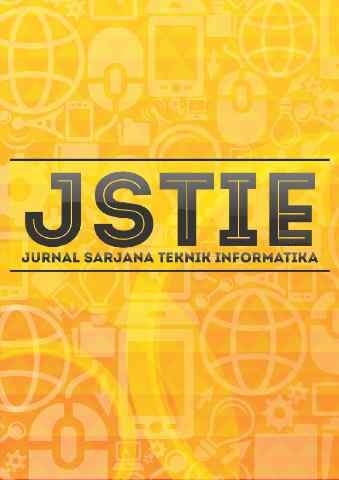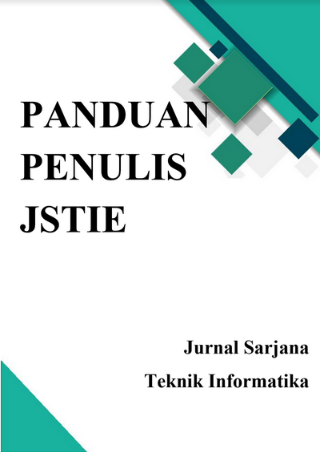Identifikasi Struktur Mikro Citra Kulit Semangka Berbasis Metode Threshold Untuk Presentase Kematangan
DOI:
https://doi.org/10.12928/jstie.v11i3.28277Keywords:
Analisis, Kematangan, Kulit, Mikro, Semangka, TresholdAbstract
Adanya kesamaan tekstur kulit buah semangka yang matang dengan yang belum matang mengakibatkan kesulitan dalam mengidentifikasi buah semangka, menyebabkan penilaian kematangan buah semangka berbeda dari satu orang dengan orang yang lainnya. Dengan menggunakan metode ambang batas, penelitian ini bertujuan untuk memperoleh informasi mendalam tentang bagaimana proses kematangan dapat dijelaskan melalui citra kulit semangka. Metode penelitian terdiri dari 3 tahap, preporocessing adalah citra RGB di konversi menjadi citra greyscale, selanjutnya melakukan reduksi noise menggunakan Median Filter pada citra hasil konvesi greyscale. Setelah itu menggunakan Otsu Thresholding yang telah melewati tahapan eduksi noise dengan disegmentasi Median Filter. Tahap pertama, yaitu preprocessing, dimulai dengan mengubah citra dari format RGB menjadi citra greyscale. Selanjutnya melibatkan reduksi kebisingan menggunakan Median Filter pada citra greyscale hasil konversi. Mengurangi gangguan dan ketidaksempurnaan pada citra, Terakhir melibatkan penggunaan Otsu Thresholding, yang merupakan teknik segmentasi, untuk memisahkan atau mengidentifikasi area kulit semangka dalam citra yang telah melewati tahapan pengurangan kebisingan. Berdasarkan hasil penelitian persentase kematangan kulit semangka sebesar 72,08%. Hal ini menunjukkan bahwa metode yang digunakan dalam analisis citra berhasil dalam menentukan tingkat kematangan buah secara relatif akurat
References
A. R. and E. Drawana Pertiwi, “Respon Tanaman Semangka (Citrullus vulgaris L.) pada Berbagai Pemangkasan Buah Semangka,” Perbal J. Pertan. Berkelanjutan, vol. 10, no. 3, pp. 376–382, 2022, doi: 10.30605/perbal.v10i3.2102.
P. Niwanggalih, J. Waluyo, and I. N. Asyiah, “Pengaruh ekstrak kulit semangka (Citrullus lanatus (Thunb.)) terhadap jumlah neutrofil pada radang luka gores mencit (Mus musculus) jantan balb/c dan pemanfaatannya sebagai karya ilmiah populer,” Artik. Ilm. Mhs. UNEJ, vol. 1, no. 1, pp. 1–4, 2014.
M. Yogi, “Aplikasi deteksi kematangan buah semangka berbasis nilai RGB menggunakan metode thresholding,” JURIKOM J. Ris. Komput., vol. 3, no. 6, pp. 84–89, 2016.
W. Lubis, A. Karim, and J. Nasution, “Limbah Kulit Buah Semangka (Citrullus lanatus) sebagai Bahan Baku Pembuatan Nata,” J. Ilm. Biol. UMA, vol. 3, no. 2, pp. 49–55, 2021, doi: 10.31289/jibioma.v3i2.736.
F. A. R. Orami, “13 Manfaat Kulit Semangka, Baik untuk Kesehatan dan Kecantikan Lho!,” october, 2022, 2022. https://www.orami.co.id/magazine/manfaat-kulit-semangka
A. Sutanto, “Ciri Ciri Buah Semangka: Mengenal dan Memilih Buah Semangka yang Berkualitas,” may, 2023, 2023.
A. N. Dzulfaroh, “CIRI CIRI SEMANGKA YANG MATANG DAN MANIS APA SAJA” april 2023, 2023. https://www.kompas.com/tren/read/2023/04/07/150000365/ciri-ciri-semangka-yang-manis-dan-matang-apa-saja-#:~:text=Dikutip dari Real Simple%2C Anda harus memilih semangka,garis-garis pucat harus berwarna krem atau kuning muda.
F. Liantoni and H. Nugroho, “KLASIFIKASI KEMATANGAN SEMANGKA BERDASARKAN EKSTRAKSI CIRI STATISTIK ORDER PERTAMA DENGAN EKUALISASI HISTOGRAM Classification of Watermelon Maturity Based on the Extraction Characteristics of First Order Statistics with Equalization of Histograms,” Inform. Pertan., vol. 28, no. 1, pp. 43–48, 2019.
I. Setiawan, W. Dewanta, H. A. Nugroho, and H. Supriyono, “Pengolah Citra Dengan Metode Thresholding Dengan Matlab R2014A,” J. Media Infotama, vol. 15, no. 2, 2019, doi: 10.37676/jmi.v15i2.868.
G. A. Sirait, N. Yudistira, and A. Ridok, “Segmentasi Citra Makanan pada Tray Box menggunakan Metode Otsu Thresholding dengan Ruang Warna,” Segmentasi Citra Makanan pada Tray Box menggunakan Metod. Otsu Threshold. dengan Ruang Warn., vol. 6, no. 2, pp. 649–657, 2022, [Online]. Available: http://j-ptiik.ub.ac.id
S. Bhahri and Rachmat, “Transformasi Citra Biner Menggunakan,” J. Sist. Inf. dan Teknol. Inf., vol. 7, no. 2, pp. 195–203, 2018.
H. S. M. Pandiangan, “Segmentasi Citra Untuk Pencarian Kode Warna Cat Menggunakan Metode Thershold Hsv,” Bull. Inf. Technol. ( BIT ), vol. 1, no. 3, pp. 134–143, 2020.
H. Z. Ahmad, “Ekstraksi statistik untuk identifikasi kematangan buah mangga berdasarkan tekstur kulit buah,” J. Inform., vol. 1, no. 1, pp. 1–4, 2018.
Noviani, “Peningkatan Kualitas Citra Karikatur Menggunakan Filter Maksimum dan Filter Median,” Jpurnal Comput. Informatics Res., vol. 1, no. 1, pp. 1–6, 2021.
G. Made, S. Arta, I. Made, O. Widyantara, and I. Nyoman Pramaita, “Multi Thresholding Berbasis Algoritma Sinus Cosinus Untuk Segmentasi Citra Pantai,” pp. 104–110.
Downloads
Published
Issue
Section
License
License and Copyright Agreement
In submitting the manuscript to the journal, the authors certify that:
- They are authorized by their co-authors to enter into these arrangements.
- The work described has not been formally published before, except in the form of an abstract or as part of a published lecture, review, thesis, or overlay journal. Please also carefully read Journal Posting Your Article Policy.
- The work is not under consideration for publication elsewhere.
- The work has been approved by all the author(s) and by the responsible authorities – tacitly or explicitly – of the institutes where the work has been carried out.
- They secure the right to reproduce any material that has already been published or copyrighted elsewhere.
- They agree to the following license and copyright agreement.
Copyright
Authors who publish with Jurnal Sarjana Teknik Informatika agree to the following terms:
- Authors retain copyright and grant the journal right of first publication with the work simultaneously licensed under a Creative Commons Attribution License (CC BY-SA 4.0) that allows others to share the work with an acknowledgement of the work's authorship and initial publication in this journal.
- Authors are able to enter into separate, additional contractual arrangements for the non-exclusive distribution of the journal's published version of the work (e.g., post it to an institutional repository or publish it in a book), with an acknowledgement of its initial publication in this journal.
- Authors are permitted and encouraged to post their work online (e.g., in institutional repositories or on their website) prior to and during the submission process, as it can lead to productive exchanges, as well as earlier and greater citation of published work.








